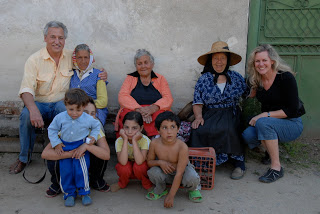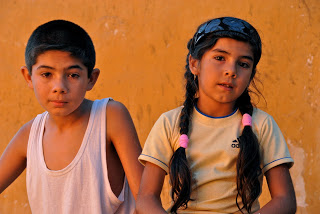Travel Tuesday
It was getting later into the afternoon by the time we left Frau Sonnleitner, her pigs, and her dog named Linda. (See Going to the Dogs) with no luck in finding the Ebner Hof, my great-grandfather, Samuel Ebner’s, home in Grosspold, Romania.
Pastor Meitert said he would make further inquiries on his own, and we could check with him the next day. Right now, he wanted to show us the “Zigeuner” (gypsy) part of town. Today “gypsies” prefer being called Roma. Many Roma consider “gypsy” derogatory and want to avoid the stereotypes associated with the word.
After we had passed through the main section of Grosspold, we ascended into the upper, Roma, part of town. At one of the first intersections, we saw a shirtless man hand-shoveling what appeared to be the lumbered remnants of some structure, cluttering the street. Nearby a woman was burning refuse of indeterminate origin in a fenced-in, barren, expanse of land.
Once we passed the burning rubbish, the air cleared, and we turned down the last street with small homes on either side. It was a lovely September day and groups of people were walking or sitting outside.
Everyone was unfailingly friendly, often asking to pose with us for photos. I promised I would send them all copies, which I did, through Pastor Meitert, to be sure they would get them. We were clearly an oddity. My brothers are both over six feet tall, and we three women (cousin Maria, my brother Bill’s wife, and I) range from 5’6”-5’10”, two of us very blond. Our towering height and sturdy western clothes must have made us look like gigantic aliens to the much shorter and dark-haired, dark-eyed Roma.
Although young parents and kids also dressed in western styles, the older folks, especially the women, were layered in a grab-bag of colorful clothing. House slippers with socks were the most common form of footwear for everyone.
 It appeared that running water was not universally available. We saw a young woman drawing water from a centrally-located well, pouring it into her own bucket, and then carrying it home, listing left with the weight.
It appeared that running water was not universally available. We saw a young woman drawing water from a centrally-located well, pouring it into her own bucket, and then carrying it home, listing left with the weight.
At the far end of the last street, we came to the highest part of town, where we saw a young boy and girl sitting on a wall. I thought they were quite beautiful with the setting sun lighting up their faces, and gestured to ask if I could take their picture. They agreed and looked right into the lens, with no need to “smile for the camera.”
A few steps further and we had a magnificent view of the town from whence we had climbed. As twilight drew near, we looked down on the highway and my grandmother’s church in the German part of town below. Just as in my grandmother’s time, the Roma still lived separately from, and more poorly than, the mainstream population. While we had come searching for touchstones to my grandmother’s past, we had unexpectedly met up with another ethnic group whose history has also been intertwined with Grosspold, and our visit was richer because of it.
As we turned to head back down, Pastor Meitert promised us he’d make further inquiries into the whereabouts of the Ebner Hof. When we called him the next day, he had indeed made some amazing discoveries–beyond what we expected. Coming soon.
Please leave your comments by clicking here.


I have been following your adventure and you have reeled me in! ~laughs~ Can’t wait to hear what the Pastor has found for you.
Thank you for sharing
Looking forward to the next post!
The photo of the Roma children is beautiful. I remember, when I was a child growing up in Scotland, the Romanian gypsies were referred to as “Romany” gypsies traveling around and often going from door to door selling elastic, clothes pins, or telling fortunes by crossing the palm of their customers with a silver coin. Horses used to pull their beautifully painted wagons.